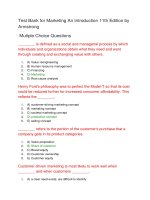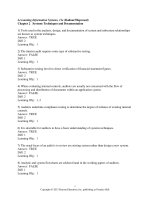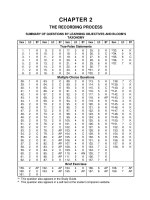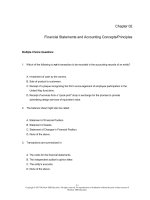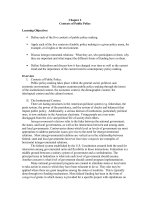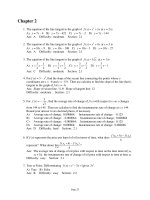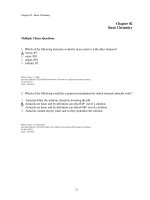Film art an introduction 11th edition bordwell test bank
Bạn đang xem bản rút gọn của tài liệu. Xem và tải ngay bản đầy đủ của tài liệu tại đây (219.22 KB, 7 trang )
Chapter 02
The Significance of Film Form
Multiple Choice Questions
1. What is the term for the relationships among the parts of a film?
A. Pattern
B. Form
C. Structure
D. Plot
Bloom’s: Remember
Learning Objective: Define form
Topic: form and pattern
2. Events involving characters that form a film's story is/are the
A. narrative elements.
B. stylistic elements.
C. cinematic structure.
D. content.
Bloom’s: Remember
Learning Objective: Define form
Topic: form and content
3. Surprise generally results from
A. an expectation that is fulfilled late in a film.
B. a predictable pattern in the film's form.
C. the buildup of suspense.
D. an expectation that turns out to be incorrect.
Bloom’s: Remember
Learning Objective: Understand how film form creates expectations
Learning Objective: Understand how film form elicits emotional response
Topic: form and feeling
Topic: formal expectations
4. Elements such as traditions, dominant styles, or popular forms that are common to several different types of art are called
A. traits.
B. genres.
C. conventions.
D. formulas.
Bloom’s: Remember
Learning Objective: Know how conventions in form define film experience
Topic: similarity and repetition in film form
5. In the judgment of a film's quality, a "criterion" is
A. an expectation experienced by spectators before the film begins.
B. a standard that can be applied to many different films.
C. a critique of the overall artistic value of the film.
D. an objective evaluation by an experienced film critic.
Bloom’s: Remember
Learning Objective: Understand how to evaluate films
Topic: evaluation
6. What kinds of emotions are most likely produced by expectations that are fulfilled?
A. Anxiety or sympathy
B. Puzzlement or increased interest
C. Sadness or joy
D. Satisfaction or relief
Bloom’s: Remember
Learning Objective: Understand how film form elicits emotional response
Topic: form and feeling
7. What is a "motif"?
A. An important element that is repeated throughout a film
B. A justification for an element appearing in a film
C. A reason for a character's actions
D. An element that creates conflict in a film
Bloom’s: Remember
Learning Objective: Understand how to pick out patterns when studying films
Topic: similarity and repetition in film form
8. Which of the following is NOT an example of a manifestation of the formal principle of difference in a film?
A. One character is in a city, and another is in a natural setting.
B. Two characters clash with each other.
C. Characters wear similar costumes or hairstyles.
D. Music varies with changes in setting.
Bloom’s: Analyze
Learning Objective: Understand the film form principle of variation
Topic: difference and variation in film form
9. Similarities between two or more distinct elements of a film are called
A. repetitions.
B. consistencies.
C. shared traits.
D. parallels.
Bloom’s: Remember
Learning Objective: Understand how to pick out patterns when studying films
Topic: similarity and repetition in film form
10. Which of the following is NOT a stylistic element of a film?
A. The way the camera moves
B. The use of music
C. The pattern of narrative events
D. The arrangement of color in a frame
Bloom’s: Understand
Learning Objective: Understand how elements in film form fulfill functions
Topic: form and content
11. A written outline that details the major and minor parts of a film, marking the parts by numbers and letters, is a
A. script.
B. segmentation.
C. form plan.
D. blueprint.
Bloom’s: Remember
Learning Objective: Understand how to look for principles of development in film form
Topic: development in film form
12. A delay in the fulfillment of an established expectation creates
A. frustration.
B. suspense.
C. confusion.
D. surprise.
Bloom’s: Remember
Learning Objective: Understand how film form creates expectations
Learning Objective: Understand how film form elicits emotional response
Topic: form and feeling
13. Comparing the beginning with the ending of a film helps spectators to understand
A. the film's overall pattern.
B. parallel elements in the film.
C. motifs in the film.
D. the film's overall message.
Bloom’s: Understand
Learning Objective: Understand how to pick out patterns when studying films
Topic: form and pattern
14. Which of the following describes a stylistic pattern used in The Wizard of Oz?
A. A tornado leads to Dorothy's journey to Oz.
B. The characters in Oz resemble characters in Dorothy's life in Kansas.
C. Dorothy's adventures in Oz result from her desire to return to Kansas.
D. Colors are used to identify landmarks and locations within the story.
Bloom’s: Understand
Learning Objective: Understand how to pick out patterns when studying films
Topic: form and pattern
15. One convention of narrative form is that
A. the conclusion of a film resolves characters' problems.
B. characters sing and dance in the film.
C. the film features thrilling scenes, such as spectacular car chases.
D. background information about characters is introduced late in the film.
Bloom’s: Remember
Learning Objective: Know how conventions in form define film experience
Topic: conventions and experience
Topic: formal expectations
16. Which of the following is NOT a type of meaning that spectators might consider in a film?
A. Referential meaning
B. Declared meaning
C. Explicit meaning
D. Implicit meaning
Bloom’s: Remember
Learning Objective: Know how form shapes a film's meaning
Learning Objective: Understand explicit meaning
Learning Objective: Understand implicit meaning
Learning Objective: Understand referential meaning
Topic: form and meaning
17. Which of the following conventions, common in current films, would have been considered unusual in the 1940s and 1950s?
A. A slow pace of events
B. Singing and dancing
C. Flashbacks to earlier events
D. The portrayal of activities that do not occur in everyday life
Bloom’s: Remember
Learning Objective: Know how conventions in form define film experience
Topic: conventions and experience
18. Which of the following works is NOT structured around a journey?
A. The Wizard of Oz
B. Collateral
C. The Lord of the Rings
D. The Odyssey
Bloom’s: Remember
Learning Objective: Know how form shapes a film's meaning
Topic: development in film form
19. Which of the following criterion for evaluating a film involves an assessment of how emotionally engaging the film is?
A. Moral judgment
B. Realistic sets
C. Intensity of effect
D. Originality
Bloom’s: Remember
Learning Objective: Understand how to evaluate films
Topic: evaluation
20. A film is said to be complex if
A. spectators have difficulty following the story line.
B. it involves numerous characters.
C. it invites spectators to think more deeply about their own real-life situations.
D. it creates multiple relations among many different formal film elements.
Bloom’s: Remember
Learning Objective: Understand the film form principle of variation
Topic: development in film form
Topic: function of film form
21. A film's "development" is based on repetition as well as
A. progression.
B. the film's ending.
C. motifs.
D. themes.
Bloom’s: Remember
Learning Objective: Understand how to look for principles of development in film form
Topic: development in film form
22. A film that is cohesive in its overall form has
A. intensity.
B. unity.
C. organization.
D. development.
Bloom’s: Remember
Learning Objective: Understand how to look for principles of development in film form
Topic: development in film form
23. Emotions experienced by spectators result from spectators' perceptions of
A. how other spectators interpret the film.
B. the film's use of conventions.
C. formal patterns in the film.
D. how closely the film's events resemble those of real life.
Bloom’s: Understand
Learning Objective: Understand how film form elicits emotional response
Topic: form and feeling
Topic: form and pattern
24. Implicit meanings are sometimes called
A. concrete elements.
B. themes.
C. interpretations.
D. subtexts.
Bloom’s: Remember
Learning Objective: Understand implicit meaning
Topic: form and meaning
25. Symptomatic meanings result from
A. the characteristics of a particular society at a particular time.
B. spectators' ability to relate to characters in the film.
C. problems that the characters in a film try to overcome.
D. flaws exhibited by the characters in a film.
Bloom’s: Understand
Learning Objective: Understand symptomatic meaning
Topic: form and meaning
True / False Questions
26. "Meaning" refers to what a film says or suggests.
TRUE
Bloom’s: Remember
Learning Objective: Know how form shapes a film's meaning
Topic: form and meaning
27. Genres are unaffected by conventions.
FALSE
Bloom’s: Remember
Learning Objective: Understand how to pick out patterns when studying films
Topic: conventions and experience
28. Emotions represented in a film are usually experienced by the audience as well.
FALSE
Bloom’s: Understand
Learning Objective: Understand how film form elicits emotional response
Topic: form and feeling
29. Social ideology is a set of values characteristic of a whole society.
TRUE
Bloom’s: Remember
Learning Objective: Define unity
Topic: form and meaning
30. Curiosity is a feeling of expectation that results when patterns of artistic cues cause spectators to think about events that came
before a certain point in the film.
TRUE
Bloom’s: Remember
Learning Objective: Understand how elements in film form fulfill functions
Topic: formal expectations
Topic: similarity and repetition in film form
31. Personal taste and evaluative judgment are virtually the same.
FALSE
Bloom’s: Remember
Learning Objective: Understand how to evaluate films
Topic: evaluation
32. Filmmakers generally strive to create artworks that invite a single interpretation—the one that the filmmaker intends.
FALSE
Bloom’s: Remember
Learning Objective: Understand how to evaluate films
Topic: evaluation
33. In film evaluation, moral criteria are used to judge certain aspects of a film outside of their film context.
TRUE
Bloom’s: Remember
Learning Objective: Understand how to evaluate films
Topic: evaluation
34. A unified film may still leave some questions unanswered or contain some unintegrated elements.
TRUE
Bloom’s: Understand
Learning Objective: Understand how to look for principles of development in film form
Topic: unity and disunity in film form
35. Prior experience has little effect on spectators' expectations as they view a film.
FALSE
Bloom’s: Understand
Learning Objective: Understand how film form creates expectations
Topic: formal expectations
36. Each major character in The Wizard of Oz fulfills a single significant function.
FALSE
Bloom’s: Remember
Learning Objective: Understand how to look for principles of development in film form
Topic: development in film form
37. Comedy often depends on creating surprise or cheating spectators' expectations.
TRUE
Bloom’s: Remember
Learning Objective: Know how form shapes a film's meaning
Topic: form and meaning
38. Variation is a fundamental principle of film form.
TRUE
Bloom’s: Remember
Learning Objective: Understand how elements in film form fulfill functions
Topic: difference and variation in film form
39. The Wizard of Oz has a large-scale ABA form.
TRUE
Bloom’s: Remember
Learning Objective: Know how conventions in form define film experience
Learning Objective: Understand form as pattern
Topic: development in film form
Topic: form and pattern
40. Referential meaning is meaning that is openly asserted in a film.
FALSE
Bloom’s: Remember
Learning Objective: Understand referential meaning
Topic: form and meaning
Essay Questions
41. How can film form create new emotional reactions in the audience instead of simply triggering practiced ones? Give an
example of how the Wizard of Oz uses form to override spectators' everyday emotional responses.
Answers will vary
Bloom’s: Apply
Learning Objective: Understand how film form creates expectations
Learning Objective: Understand how film form elicits emotional response
Topic: form and feeling
42. What can we discover about a film's "architecture" from analyzing its plot segmentation?
Answers will vary
Bloom’s: Understand
Learning Objective: Know how form shapes a film's meaning
Learning Objective: Know to compare the beginning with the ending in understanding a film's development
Learning Objective: Understand how to look for principles of development in film form
Topic: development in film form
Topic: difference and variation in film form
Topic: function of film form
Topic: similarity and repetition in film form
Topic: unity and disunity in film form
Category
# of Questions
Bloom's: Analyze
1
Bloom's: Apply
1
Bloom's: Remember
31
Bloom's: Understand
9
Learning Objective: Define form
2
Learning Objective: Define unity
1
Learning Objective: Know how conventions in form define film experience
4
Learning Objective: Know how form shapes a film's meaning
5
Learning Objective: Know to compare the beginning with the ending in understanding a film's development
1
Learning Objective: Understand explicit meaning
1
Learning Objective: Understand form as pattern
1
Learning Objective: Understand how elements in film form fulfill functions
3
Learning Objective: Understand how film form creates expectations
4
Learning Objective: Understand how film form elicits emotional response
Learning Objective: Understand how to evaluate films
Learning Objective: Understand how to look for principles of development in film form
Learning Objective: Understand how to pick out patterns when studying films
Learning Objective: Understand implicit meaning
Learning Objective: Understand referential meaning
Learning Objective: Understand symptomatic meaning
Learning Objective: Understand the film form principle of variation
Topic: conventions and experience
Topic: development in film form
Topic: difference and variation in film form
Topic: evaluation
Topic: form and content
Topic: form and feeling
Topic: form and meaning
Topic: form and pattern
Topic: formal expectations
Topic: function of film form
Topic: similarity and repetition in film form
Topic: unity and disunity in film form
6
5
6
5
2
2
1
2
3
8
3
5
2
6
7
5
4
2
5
2
